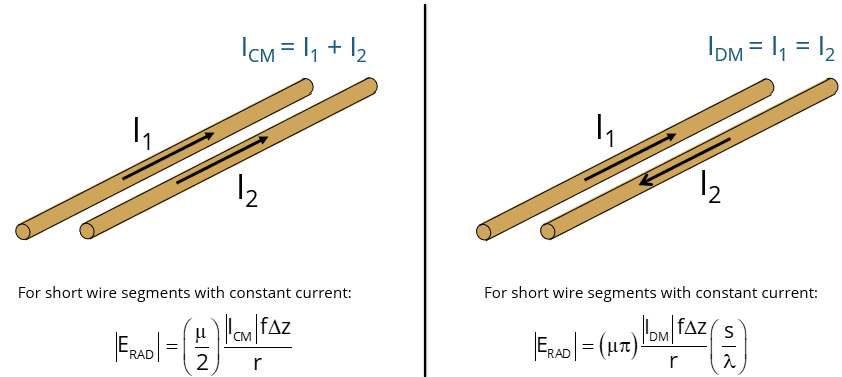EMC Question of the Week: November 27, 2023

A pair of parallel wires separated by a distance, s, carries 1 mA of differential mode current, IDM. The same pair of wires carries 1 mA of common-mode current, ICM, at the same frequency. If the wire separation is much less than a wavelength (s<<λ), the radiated field due to the differential-mode current is less than the field due to the common-mode current by a factor of
- 2π(s/λ)
- (s/λ2)
- 2πsλ2
- λ/4π
Answer
The best answer is “a.” Even if you didn't have this result memorized, there are a few clues you could use to come up with the correct answer. For example, the first choice is the only one that is unitless. The ratio of the radiated field strengths can't depend on the system of units. Also, the equations for the radiated emissions from each type of circuit are shown in the figure. The ratio of the two is 2π(s/λ). Even though these equations are for a constant current distribution, using superposition, any current distribution could be expressed as a sum of constant current segments without affecting the ratio of the resulting fields.
This result is important when trying to understand the importance of differential-mode radiation compared to radiation from common-mode currents. When s<<λ, the differential-mode radiation is much less than the common-mode radiation. For example, an untwisted pair of #24 wire might typically have a wire separation of 1 mm. At 30 MHz (λ = 10 m), the differential-mode radiation would be 2π x 10-4 (64 dB) lower than the radiation from the same amount of common-mode current. For virtually every reasonable transmission line, the unintentional emissions due to differential-mode radiation are negligible. Even at 1 GHz, the differential-mode radiation from the #24 wire pair would be 33 dB lower than the common-mode radiation. (Of course, at 1 GHz the wire pair is likely to be twisted, reducing the differential-mode radiation even more).
In many applications, a few microamps of common-mode current on a cable can cause significant radiated emissions. On the other hand, as long as the current and current-return paths are close, differential-currents can be orders of magnitude stronger without radiating significantly.
Have a comment or question regarding this solution? We'd like to hear from you. Email us at
